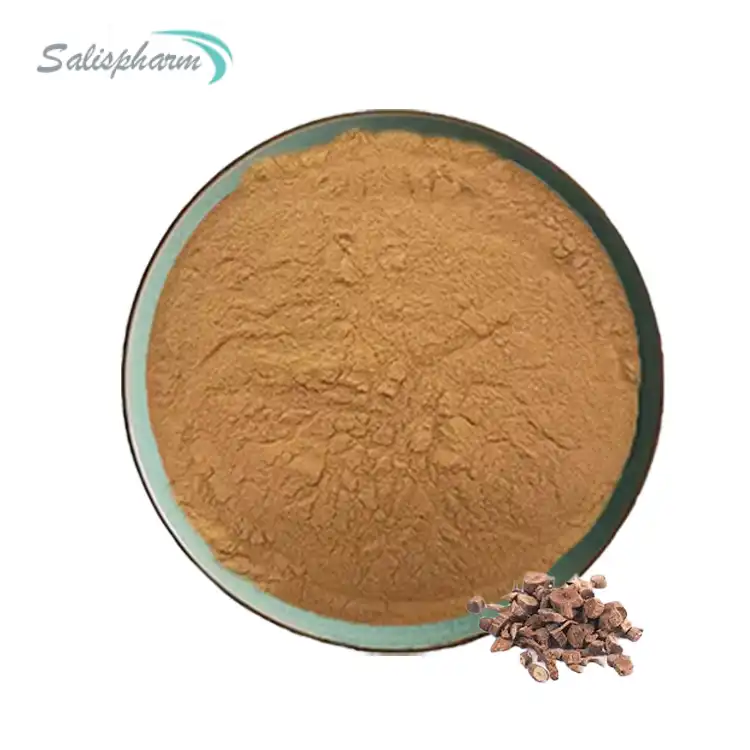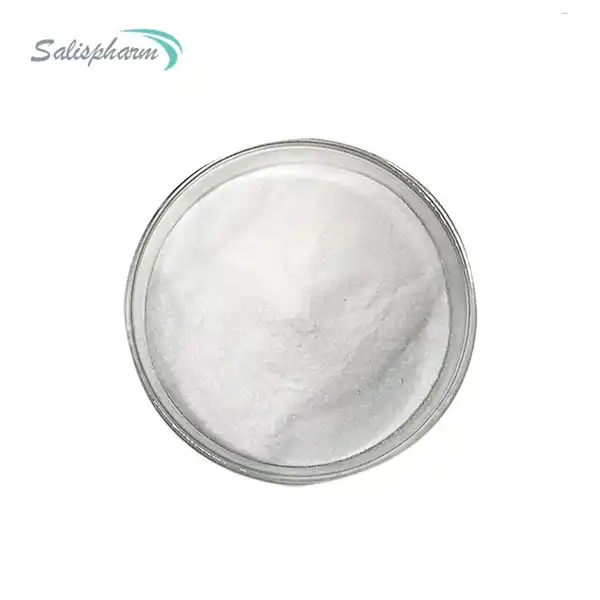Loperamide HCl powder and Imodium powder are essentially the same thing. Loperamide hydrochloride is the active ingredient in Imodium, a popular over-the-counter medication used to treat diarrhea. Imodium is simply the brand name for loperamide HCl. Both contain the same active compound and work in the same way to alleviate symptoms of diarrhea. Understanding the relationship between these two terms is crucial for consumers and healthcare professionals alike.
What is the difference between loperamide HCl and loperamide?
The main difference between loperamide HCl and loperamide lies in their chemical composition and formulation. Loperamide is the base compound, while loperamide HCl is its hydrochloride salt form. The addition of hydrochloride (HCl) to loperamide creates a more stable and water-soluble version of the drug, which is advantageous for pharmaceutical use.
Loperamide HCl is the form most commonly used in medications because it offers better absorption and bioavailability in the body. When you take loperamide HCl, it dissociates in the stomach's acidic environment, releasing the active loperamide molecule. This process allows for more efficient uptake by the body, leading to improved therapeutic effects.
The chemical structure of loperamide HCl includes an additional chloride ion compared to the base loperamide molecule. This slight modification doesn't change the drug's primary mechanism of action but enhances its pharmaceutical properties. In terms of efficacy, both forms ultimately provide the same therapeutic benefits, as the active loperamide molecule is responsible for the antidiarrheal effects.
It's worth noting that when you see "loperamide" listed as an ingredient on medication labels or in medical literature, it often refers to loperamide HCl unless specifically stated otherwise. This is because the hydrochloride salt form is the standard in pharmaceutical preparations.
For patients and consumers, the distinction between loperamide and loperamide HCl is generally not significant in terms of usage or effectiveness. Both forms work to slow down intestinal motility and reduce fluid secretion in the bowels, thereby alleviating diarrhea symptoms. However, healthcare professionals and pharmacists need to be aware of this difference, especially when dealing with precise dosing or compounding medications.
Can you overdose on loperamide HCl powder?
While loperamide HCl is generally considered safe when used as directed, it is indeed possible to overdose on this medication, including its powder form. Overdosing on loperamide HCl can lead to severe and potentially life-threatening complications, particularly affecting the heart and nervous system.
The risk of overdose has become a growing concern in recent years due to the misuse of loperamide as a recreational drug or as a means to self-treat opioid withdrawal symptoms. When taken in extremely high doses, loperamide can cross the blood-brain barrier and produce opioid-like effects, which has led some individuals to abuse the drug.
Symptoms of a loperamide HCl overdose may include:
1. Severe constipation
2. Nausea and vomiting
3. Abdominal pain
4. Dizziness and fainting
5. Irregular heartbeat or cardiac arrhythmias
6. QT interval prolongation (a heart rhythm disorder)
7. Respiratory depression
8. Loss of consciousness
In severe cases, loperamide overdose can lead to cardiac arrest, respiratory failure, or even death. The U.S. Food and Drug Administration (FDA) has issued warnings about the cardiac risks associated with high doses of loperamide and has taken steps to limit package sizes and strengthen warnings on product labels.
It's crucial to adhere to the recommended dosage guidelines when using loperamide HCl powder or any form of the medication. For adults and children 12 years and older, the typical recommended dose is 4 mg initially, followed by 2 mg after each loose stool, not to exceed 16 mg per day for over-the-counter use. Higher doses may be prescribed by a healthcare provider for specific conditions but should never be taken without medical supervision.
Healthcare professionals should be aware of the potential for loperamide abuse and educate patients about the dangers of exceeding the recommended dose. Patients with a history of substance abuse or those taking medications that interact with loperamide should be monitored closely.
How long does loperamide HCl powder stay in your system?
Understanding how long loperamide HCl powder remains in the system is important for both therapeutic use and potential drug interactions. The duration of loperamide's presence in the body depends on several factors, including dosage, individual metabolism, liver function, and frequency of use.
Loperamide HCl has a relatively long half-life compared to many other over-the-counter medications. The average half-life of loperamide in healthy adults is approximately 10-13 hours. However, this can extend to 40-50 hours in some individuals, particularly those with liver impairment or who have taken larger doses.
Given its half-life, it typically takes about 5-6 half-lives for a drug to be considered fully eliminated from the body. For loperamide, this means it can take anywhere from 2-3 days to over a week for the drug to be completely cleared from the system in most people.
The extended presence of loperamide in the body contributes to its effectiveness in treating diarrhea, as it continues to exert its effects on the intestines over time. However, this prolonged duration also means that the risk of drug interactions and cumulative effects persists for several days after the last dose.
Factors affecting how long loperamide stays in your system include:
1. Liver function: The liver is primarily responsible for metabolizing loperamide. Individuals with impaired liver function may clear the drug more slowly.
2. Age: Older adults may metabolize and eliminate the drug more slowly due to natural changes in liver and kidney function.
3. Dosage and frequency of use: Higher doses or regular use over extended periods can lead to accumulation in the body, potentially extending the time it takes to clear the drug.
4. Individual metabolism: Genetic factors and overall metabolic rate can influence how quickly the body processes and eliminates loperamide.
5. Hydration and diet: While not as significant as other factors, hydration levels and dietary habits can affect drug metabolism and elimination to some extent.
It's important to note that while loperamide may no longer be detectable in blood tests after a few days, it can still be present in urine for a longer period. This is relevant for drug testing purposes, although loperamide is not typically included in standard drug screens.
For patients taking loperamide HCl powder or any form of the medication, it's advisable to inform healthcare providers about its use, especially before starting new medications or undergoing medical procedures. The prolonged presence of loperamide in the system can potentially interact with other drugs or affect medical assessments.
Healthcare professionals should consider the extended half-life of loperamide when prescribing or recommending the medication, particularly for patients with liver issues or those taking other medications that might interact with loperamide. Monitoring for potential side effects or interactions should continue for several days after the last dose.
In conclusion, loperamide HCl powder, the active ingredient in Imodium, is a widely used and generally safe antidiarrheal medication when used as directed. Understanding its relationship to the brand name Imodium, the potential for overdose, and its duration in the body is crucial for safe and effective use. As with any medication, it's important to follow dosage instructions carefully and consult with a healthcare provider if you have any concerns or questions about its use.
References:
1. U.S. Food and Drug Administration. (2018). FDA Drug Safety Communication: FDA limits packaging for anti-diarrhea medicine loperamide (Imodium) to encourage safe use.
2. Jaffe, J. H., Kanzler, M., & Green, J. (1980). Abuse potential of loperamide. Clinical Pharmacology & Therapeutics, 28(6), 812-819.
3. Eggleston, W., Clark, K. H., & Marraffa, J. M. (2017). Loperamide abuse associated with cardiac dysrhythmia and death. Annals of Emergency Medicine, 69(1), 83-86.
4. Katzung, B. G. (2018). Basic & Clinical Pharmacology, 14e. McGraw-Hill Education.
5. Wu, P. E., & Juurlink, D. N. (2017). Clinical review: Loperamide toxicity. Annals of Emergency Medicine, 70(2), 245-252.
6. Hanauer, S. B. (2008). The role of loperamide in gastrointestinal disorders. Reviews in Gastroenterological Disorders, 8(1), 15-20.
7. Baker, D. E. (2007). Loperamide: a pharmacological review. Reviews in Gastroenterological Disorders, 7, S11-S18.
8. Regnard, C., Twycross, R., Mihalyo, M., & Wilcock, A. (2011). Loperamide. Journal of Pain and Symptom Management, 42(2), 319-323.
9. Awouters, F., Niemegeers, C. J., Kuyps, J., & Janssen, P. A. (1975). Loperamide antagonism of castor oil-induced diarrhea in rats: a quantitative study. Archives Internationales de Pharmacodynamie et de Therapie, 217(1), 29-37.
10. Litovitz, T., Clancy, C., Korberly, B., Temple, A. R., & Mann, K. V. (1997). Surveillance of loperamide ingestions: an analysis of 216 poison center reports. Journal of Toxicology: Clinical Toxicology, 35(1), 11-19.









